Home theater subs suck for music. They’re slow, boomy, and aren’t designed to reproduce the subtle low end in jazz or electronic music. A dedicated subwoofer for music is designed differently from a typical home theatre sub; they have sealed enclosures and an emphasis on control.
After testing numerous subwoofers with different speakers over the years, here are the ones that actually work for stereo music systems. These integrate well with bookshelf and tower speakers without overpowering your mids or making everything sound muddy. If you’re looking for the best subwoofer for music, then this list is for you.
Best Overall: Bowers & Wilkins ASW610 ($1000.00)

The ASW610 is what happens when a proper hi-fi company decides to build a subwoofer that actually understands music. Although this is an older product, Bowers & Wilkins crafted something infinitely more musical than most of the subs you see today, and I’ve been using this subwoofer in my setup for about 4 years.
The sealed enclosure keeps the bass “good and tight (and exciting!)” according to B&W themselves, and they’re not wrong. Unlike ported designs that can sound loose and overblown with music, the ASW610 has perfect control over your music. The long-throw 10-inch driver moves a good amount of air volume while the 200W Class D amplifier keeps everything running cool, which means consistent performance.
The compact cabinet won’t take much space in your listening room, and B&W even suggests “maybe use two for more bass control”, a very stereo-minded approach that home theater brands rarely consider. The comprehensive control panel gives you proper adjustment options rather than basic on/off switches. This is the best subwoofer for music, and the best subwoofer for small rooms, and I highly recommend it if you’re in the market for a subwoofer.
Pros:
- Compact and unobtrusive design, making it easy to place in any room.
- Delivers well-extended and tight bass for its size, with excellent control over your music.
- High-quality build with a good finish and comprehensive controls for customization, including low-pass filters and a phase switch.
- Option to use two units for improved bass control and stereo setups.
Cons:
- Sealed design may lack the deep, rumbling extension for intense movies, compared to ported subs.
- Sounds bigger than it looks, but it might not match the output of larger or more powerful competitors in bigger rooms.
Best Budget Subwoofer For Music: Yamaha NS-SW100BL ($249.95)

The Yamaha NS-SW100 won’t win any awards for power, but what it lacks in brute force, it more than makes up for in finesse and restraint, qualities that matter when you’re listening to music. It is the best budget subwoofer in my opinion, and it is an amazing component that could take your music system to the next level.
The 10-inch cone woofer sits in a compact cabinet that won’t dominate your living room or announce its presence to everyone within a three-block radius. The Twisted Flare Port diffuses air turbulence around the port opening, which translates to cleaner bass without chuffing noises. Yamaha’s Advanced YST II technology keeps the cone under tight control, and you get bass that starts and stops when it should.
It’s designed for people with bookshelf speakers in normal-sized rooms who want their music to have a proper foundation without overwhelming everything else.
Pros:
- Affordable entry-level option with clear, tight bass.
- Provides stable, accurate low-range response, making it suitable for music without overwhelming the mix.
- Good for enhancing bass in music and movies, with realistic reproduction for live venue atmospheres.
- Front controls and multiple inputs for easy setup and integration.
Cons:
- Limited power, not suitable for large rooms or high-power systems.
- Not ideal for systems needing significant low-end extension, as it focuses more on finesse than volume.
Best Subwoofer For Bookshelf Speakers: SVS SB-2000 Pro ($899.00)

If you’ve got quality bookshelf speakers and want a subwoofer that enhances your bass and listening experience, then the SVS SB-2000 Pro is your answer. The sealed cabinet design delivers bass extension down to 19Hz with precision. The 12-inch driver combines an aluminum vented cone with a dual ferrite magnet assembly weighing over 15 pounds, giving you controlled, musical bass.
The SVS smartphone app provides three custom presets, parametric EQ, and real-time adjustments from your listening position. This means that you don’t have to manually remove any wires or tweak the passthrough from the sub itself; you can do it right from your phone.
The Sledge STA-550D amplifier delivers 550 watts with the efficiency of Class D amplifiers and the current delivery of discrete MOSFETs, providing effortless power without the heat buildup. This means consistent performance and no overheating issues, something that is talked about very little nowadays.
At $900, it costs more than basic alternatives, but the combination of app control, the sealed design, and intelligibility makes it an incredible choice for anyone with decent bookshelf speakers. I tested it with my Monitor Audio Gold 100G bookshelf speakers, and the sub worked wonders in that setup.
Pros:
- Exceptional deep bass extension down to 19Hz with high output and pinpoint accuracy.
- Compact sealed design that maintains musicality and transient speed.
- Smartphone app for easy control, including parametric EQ, presets, and real-time adjustments.
- Superior for music compared to ported alternatives in the range, with better control and integration.
Cons:
- Less maximum output in the deep bass octave (18-36Hz) compared to ported models like the PB-2000 Pro.
- Higher price point for sealed design, which may not suit budget-conscious users seeking more boom.
Best Subwoofer For Floorstanding Speakers: Rel T/9x ($1297.65)

REL built their reputation on one simple philosophy: subwoofers should enhance music, not dominate it. The T/9x embodies this thinking perfectly, delivering audiophile-grade performance that works really well in both stereo and home theater setups.
The high-level input uses a Neutrik Speakon connector that connects directly to your amplifier’s speaker terminals, meaning the subwoofer sees exactly the same signal as your main speakers. This makes the REL T/9x blend in with your soundstage and the crossover smoother. The 300-watt Class A/B amplifier drives both a 10-inch front-firing active driver and a 10-inch down-firing passive radiator, creating what REL calls “outsized performance” from a relatively compact cabinet. The passive radiator design gives you more output than a sealed box while maintaining better control than traditional ported designs.
At $1297, the T/9x represents REL’s sweet spot, and it is the best subwoofer for listening to music with floorstanding speakers. It sounds big in a compact body and elevates your listening experience.
Pros:
- Delivers high output, dynamics, and clarity with a 10″ active driver and passive radiator.
- Musical and accurate bass with fast response and texture for various genres.
- High-level input for better integration with main speakers, plus optional wireless connections.
- Easy to integrate with other REL models for stereo or 3D configurations.
Cons:
- Limited deep extension (-6dB at 27Hz), which may not suffice for setups needing ultra-low bass.
- Potential hum or noise issues when using wirelessly.
How To Choose A Subwoofer
Choosing the best subwoofer for music isn’t about finding the loudest option; it’s about finding one that integrates seamlessly with your existing speakers and room. Here’s what actually matters.
Sealed vs Ported Subwoofers
Sealed subwoofers win for music reproduction because they operate faster. The air trapped inside acts like a spring, giving you tighter control over the driver’s movement. This translates to cleaner bass with music where timing matters.
Ported designs can work for music, but they’re optimized for maximum output rather than precision. The port extends low-end response but can create timing issues where the port output lags behind the driver. Unless you’re in a very large room or primarily listen to bass-heavy genres, sealed designs integrate better with stereo speakers.
Match Your Room Size
Small rooms (under 200 square feet) can be overwhelmed by large subwoofers. An 8-10-inch sealed design will give you proper bass extension without overpowering your space or main speakers. Medium rooms (200-400 square feet) work well with 10-12 inch designs. This covers most living rooms and dedicated listening spaces. You need enough driver surface area to pressurize the space without strain. Large rooms (400+ square feet) benefit from 12-inch drivers or dual smaller subs. Single large drivers can work, but two smaller subs often give you a smoother response across multiple listening positions.
Integration
When choosing a sub, you have to think about how it will work with your existing system, mainly your existing set of speakers. Bookshelf speakers typically benefit from higher crossover frequencies (80-120Hz) since they naturally roll off earlier. Tower speakers with larger woofers might work better with lower crossover points (60-80Hz) to avoid overlap.
Start with 80Hz as your crossover frequency and adjust by ear. If male vocals sound thin, lower the frequency. If the bass sounds disconnected from your main speakers, raise it. The goal is seamless blending where you can’t tell where your speakers end and the subwoofer begins.
FAQs
What is the best subwoofer for music in 2025?
The best subwoofer for music depends on your setup and budget, but the Bowers & Wilkins ASW610 stands out as an overall top pick for its tight, musical bass from a sealed enclosure and long-throw 10-inch driver. For audiophiles seeking precision and integration, it enhances tracks without overpowering mids or highs.
What is the best budget subwoofer for music under $300?
The Yamaha NS-SW100 is an excellent budget choice under $300, offering amazing performance with its Twisted Flare Port for clear bass and Advanced YST II technology for controlled response. It’s ideal for small rooms or bookshelf speakers, providing a solid foundation for music without muddiness.
Should I choose a sealed or ported subwoofer for music listening?
Sealed subwoofers like the SVS SB-2000 Pro or Bowers & Wilkins ASW610 are often better for music due to their tight, accurate bass and faster transient response, avoiding the boominess sometimes found in ported designs. Ported options can work for added depth, but sealed models excel in clarity—experts recommend them for stereo setups to maintain musicality without distortion.
How can I set up a subwoofer to avoid common bass issues like boominess?
To avoid boominess, calibrate using tools like the subwoofer’s dedicated app. Place the sub away from walls as needed, and use room correction software like Dirac and Audyssey. Start with a crawl test (move the sub while listening) and adjusting low-pass filters, until you find the sweet spot.
